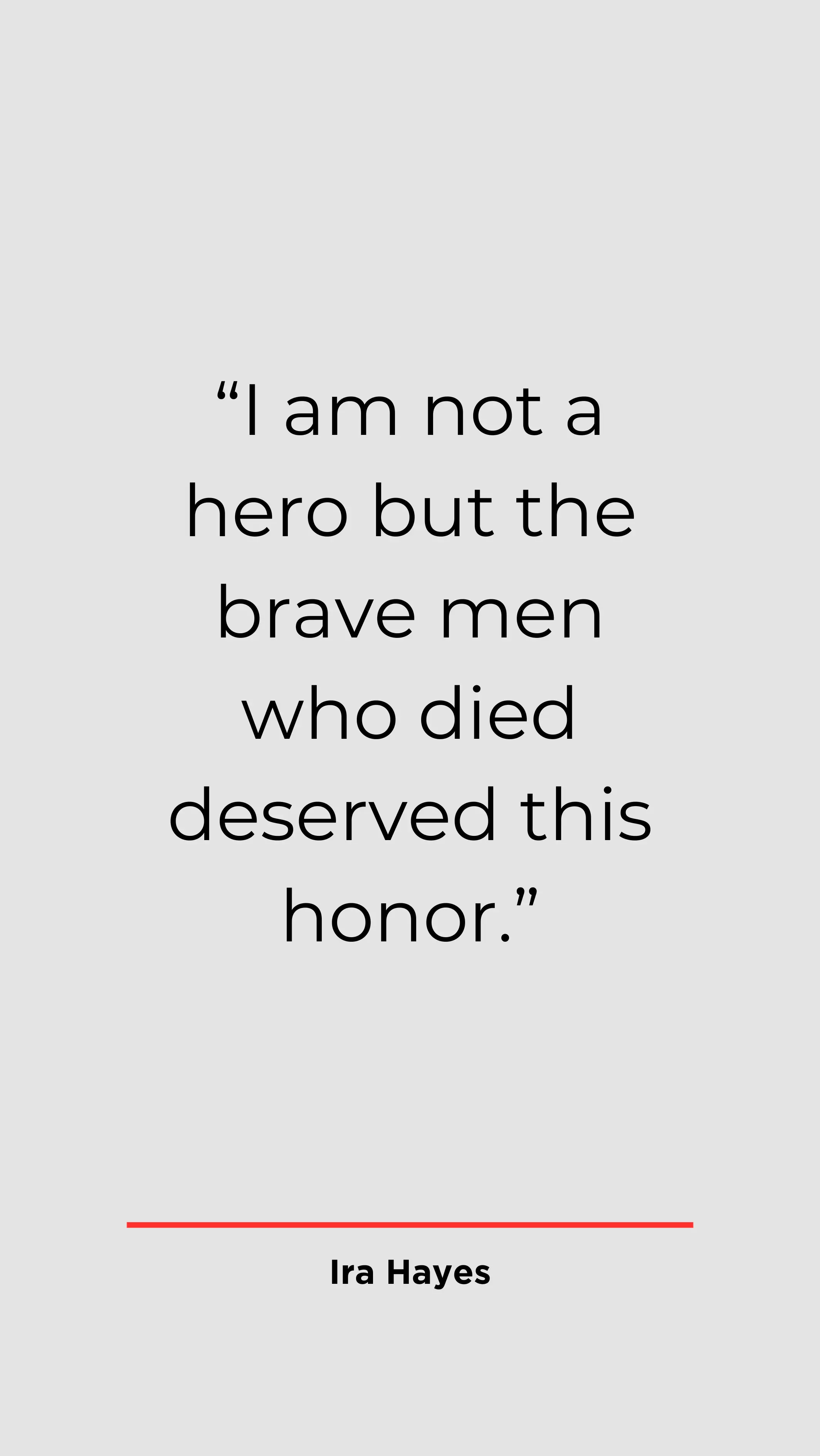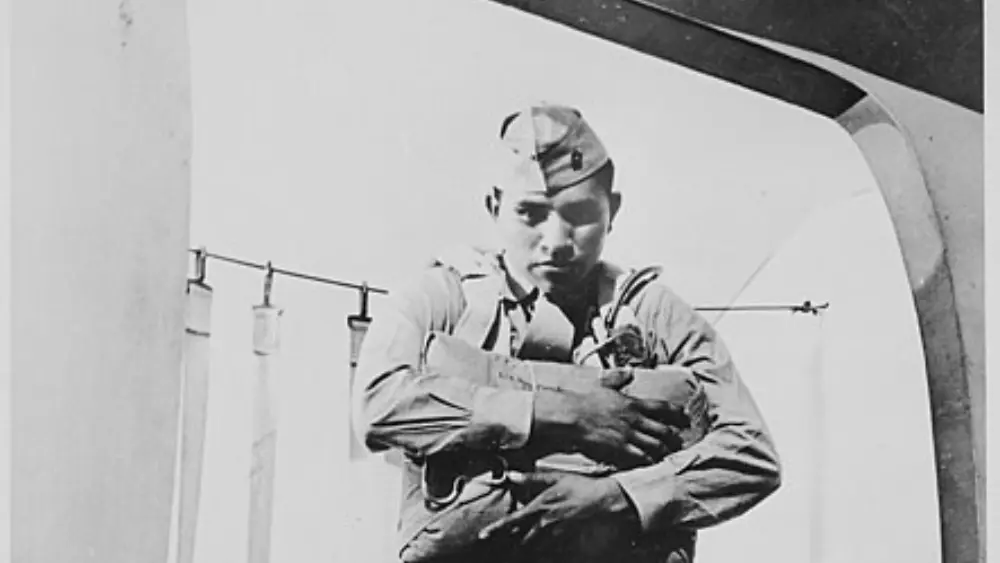Ira Hayes, a Native American and U.S. Marine, became an iconic symbol of heroism during World War II for his role in raising the American flag on Mount Suribachi during the Battle of Iwo Jima. Born on January 12, 1923, on the Pima Indian Reservation in Arizona, Hayes’ life story is one of courage, service, and the enduring power of an iconic photograph.
Early Life and Enlistment
Ira Hayes’s early life unfolded amidst the serene yet humble surroundings of the Gila River Indian Community in Arizona. Born into a close-knit family, he experienced the simplicity and values of his Native American heritage. In the early 1940s, amid global turmoil, Hayes unwaveringly answered the nation’s call to defend freedom, joining its ranks. In 1942, he took the decisive step of enlisting in the United States Marine Corps, beginning a journey that would transform his life and leave a significant legacy in American history.
Hayes’s enlistment in the Marine Corps marked the beginning of a remarkable and challenging chapter in his life. His choice to serve showed both personal duty and deep commitment to his nation’s liberty and justice principles. Unaware, he rose from humble beginnings to become an enduring hero in American military history, symbolizing courage and sacrifice.
Ira Hayes: Marine Training and Deployment
After rigorous training, Ira Hayes joined the 5th Marine Division for the next phase of his military career. This assignment marked the start of his active service in the U.S. Marine Corps, a momentous step in his life. Hayes eagerly embraced his role with duty, purpose, and full awareness of forthcoming challenges and responsibilities. Soon, he boarded a troop ship for the Pacific Theater, where World War II’s intensity was profoundly experienced. Unaware, his deployment tested his mettle and made him a symbol of bravery and resilience in the face of adversity.
Hayes’ journey from training to deployment represents a pivotal juncture in his life as a Marine. His assignment to the 5th Marine Division symbolized the culmination of his preparation and the commencement of his active service. Stepping onto the Pacific-bound troop ship, he began an adventure that defined his lasting legacy, marked by harrowing experiences. Sailing toward war’s epicenter, Hayes had no idea of his future as a Marine, a symbol of sacrifice and valor. His story, woven into American history, testifies to the unwavering dedication of those who answered the call during turbulent times.
The Battle of Iwo Jima
In February 1945, a pivotal chapter in World War II unfolded with the commencement of the Battle of Iwo Jima. In the Pacific theater, an unassuming volcanic island emerged as a fierce battleground in a pivotal World War II conflict. American forces, upon landing, engaged in an unrelenting battle for control, battling tough terrain and a formidable Japanese defense. Iwo Jima’s historic impact lies in its strategic value and the unwavering courage of U.S. Marines, leaving a lasting mark. It’s a reminder of brave sacrifices, highlighting the human cost of war.
The Battle of Iwo Jima encapsulated in its brutal intensity, serves as a microcosm of the larger war effort. Marines on volcanic outpost displayed unwavering dedication, resilience, and commitment amid harrowing conditions, showcasing Allied strength. The iconic flag-raising on Mount Suribachi symbolizes camaraderie, determination, and a victorious spirit, defining soldiers’ enduring legacy. Iwo Jima’s enduring memory symbolizes remarkable bravery and sacrifices in the quest for freedom on that Pacific island.
Ira Hayes: Raising the Flag on Mount Suribachi
On February 23, 1945, a defining moment in American military history unfolded atop the rugged terrain of Mount Suribachi. Brave Marines, led by Ira Hayes, scaled a volcanic island in a historic act of patriotism during a harrowing ascent. Atop that craggy peak, they unfurled the American flag, a symbol of freedom and unwavering resolve. Joe Rosenthal’s lens immortalized a moment of valor and camaraderie, defining the essence of World War II in an instant. Rosenthal’s etched photo, iconic in the conflict’s annals, symbolized the indomitable American spirit and sacrifices for liberty, resonating through time.
Ira Hayes, an ordinary man, symbolized the courage of countless individuals during a crucial era, becoming an enduring symbol. His journey, both literal and symbolic, testifies to the enduring spirit of those who answered duty’s call in history’s trials. Mount Suribachi’s flag symbolizes brave soldiers’ unwavering commitment to safeguarding freedoms through their sacrifices. This iconic photo symbolizes American resilience, honoring those who served selflessly during challenging times.
The Photograph’s Impact
Rosenthal’s photo deeply resonated, etching into America’s collective consciousness an extraordinary feat amid a nation seeking inspiration. The image of Marines raising the American flag on Mount Suribachi transcended as a potent symbol of hope and determination. It stood as a beacon during a dark time, reminding Americans that unity and fortitude could prevail in wartime.
The impact of this iconic image reached far beyond the moment it was captured, leaving a lasting impression on the American psyche. It served as a rallying point, a visual embodiment of the enduring spirit that carried the nation through the trials of World War II. Rosenthal’s photograph, with its power to inspire, remains an enduring testament to the human capacity for bravery and the ability of a single image to galvanize a nation towards a common purpose.
Ira Hayes: Return to the United States
Upon their triumphant return to the United States, Ira Hayes and the valiant flag-raisers were hailed as national heroes, and their unwavering valor and unyielding commitment to their country were celebrated across the nation. Their iconic image, immortalized in the photograph capturing the raising of the American flag on the volcanic sands of Iwo Jima, had become a symbol of American resilience and determination during the unruly days of World War II. It was a moment that transcended mere symbolism, a testament to the bravery and sacrifice of those who had fought tirelessly on the front lines.
In recognition of their service, Ira Hayes and his fellow flag-raisers embarked on a noble mission to support the war effort. They crisscrossed the country, participating in a bond tour that aimed to rally the American public and generate crucial funds to sustain the war. Their journey was a testament to their unwavering dedication to their country, as they sought to ensure that the sacrifices made by their comrades in arms were not in vain. Hayes and his compatriots not only raised much-needed resources but also embodied the spirit that had defined their generation’s fight for freedom. Their efforts left a lasting legacy in the collective memory of the United States.
Challenges and Personal Struggles
Amidst the glare of newfound fame, Ira Hayes grappled with profound personal challenges. The trauma of war etched lasting wounds into his mind, invisible yet heavy, and too often forgotten in the triumph of victory. Hayes thrust into the spotlight as a symbol of heroism, found himself ensnared by the weighty expectations society had placed upon him.
Haunted by memories of battle and grappling with the emotional toll of his wartime experiences, Hayes’s struggles were a stark reminder of the hidden cost of heroism. As he navigated the complexities of his newfound status, he embarked on a deeply personal journey. It was a path that would test the resilience of his spirit and illuminate the enduring challenges faced by veterans returning from the frontlines of conflict.

Ira Hayes: Legacy and Remembrance
Ira Hayes’ legacy honors Native Americans’ sacrifices in service to their nation, a lasting tribute to their profound dedication. Hayes’s role in the Iwo Jima flag-raising image symbolizes the nation’s spirit during adversity, transcending photography with its potent essence.
His legacy challenges us to honor the contributions of Native Americans and all those who have served in the armed forces. It fosters a deeper appreciation for the diverse tapestry of heroes who have shaped the United States’ history and ideals.











